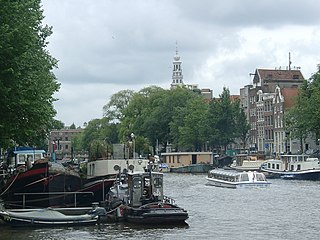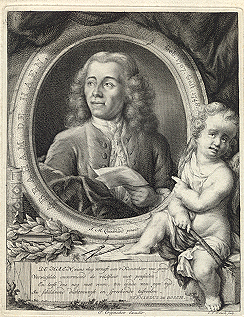
The Dutch East India Company, officially the United East India Company, was a multinational corporation founded by a government-directed consolidation of several rival Dutch trading companies in the early 17th century. It is believed to be the largest company to ever have existed in recorded history. It was established on March 20, 1602, as a chartered company to trade with Mughal India in the early modern period, from which 50% of textiles and 80% of silks were imported, chiefly from its most developed region known as Bengal Subah. In addition, the company traded with Indianised Southeast Asian countries when the Dutch government granted it a 21-year monopoly on the Dutch spice trade.

Johan Anthoniszoon "Jan" van Riebeeck was a Dutch navigator and colonial administrator of the Dutch East India Company.

Gabriël Metsu (1629–1667) was a Dutch painter of history paintings, still lifes, portraits, and genre works. He was "a highly eclectic artist, who did not adhere to a consistent style, technique, or one type of subject for long periods". Only 14 of his 133 works are dated.

Simon van der Stel was the last commander and first Governor of the Dutch Cape Colony, the settlement at the Cape of Good Hope.

Kota Tua Jakarta, officially known as Kota Tua, is a neighborhood comprising the original downtown area of Jakarta, Indonesia. It is also known as Oud Batavia, Benedenstad, or Kota Lama.

Johan Nieuhof was a Dutch traveler who wrote about his journeys to Brazil, China and India. The most famous of these was a trip of 2,400 kilometers (1,500 mi) from Canton to Peking in 1655-1657, which enabled him to become an authoritative Western writer on China. He wrote An embassy from the East-India Company containing the written account of this journey.

Cornelis de Graeff, also Cornelis de Graeff van (Zuid-)Polsbroek was the most illustrious member of the De Graeff family. He was a mayor of Amsterdam from the Dutch Golden Age and a powerful Amsterdam regent after the sudden death of stadholder William II of Orange, during the First Stadtholderless Period. Like his father Jacob Dircksz de Graeff, he opposed the house of Orange, and was the moderate successor to the republican Andries Bicker. In the mid 17th century he controlled the city's finances and politics and, in close cooperation with his brother Andries de Graeff and their nephew Johan de Witt, the Netherlands political system.

Pieter de Graeff, was a member of the De Graeff-family from the Dutch Golden Age. He was an Amsterdam Regent during the late 1660s and the early 1670s, and held the titles as Lord of the semi-sovereign Fief Zuid-Polsbroek and 19.th Lord of the Free and high Fief Ilpendam and Purmerland. Pieter de Graeff was a member of a family of regents who belonged to the republican political movement also referred to as the ‘state oriented’, as opposed to the Royalists.

Constanti(j)n Ranst de Jonge was a Dutch businessman employed by the Dutch East India Company (VOC) who was chief of the trading posts in Tonkin and Dutch Bengal and three times opperhoofd of Dejima in Japan.

Andries Beeckman was a Dutch painter of the 17th century. He is especially famous for his paintings of Southeast Asia and Batavia c. 1660. In 1657 he was known as Andries Beeckman from Zutphen and is last mentioned as finishing two paintings in Amsterdam in 1663. An Andries Beeckman was buried on August 9, 1664 in the Nieuwe Kerk (Amsterdam)

Abraham de Haen, also known as Abraham de Haan, was a Dutch draughtsman and engraver known particularly for his drawings of castles and manors. He was also a painter and poet.
Joan Paul Schaghen was an acting Governor of Ceylon in 1725 and 1726 and director-general of the council of the Dutch East India Company in Batavia from 1737 to 1741.
Jacobus Anthonie Meessen was a Dutch photographer who took more than 250 portraits and landscapes of the Dutch East Indies between 1864 and 1870. Born to a carpenter in Utrecht, Meessen worked in that trade in the Indies before marrying in the Netherlands in the early 1860s. He returned to the colony in 1864, intent on documenting its land and people. He worked mostly in the capital of Batavia, Java, and Padang, Sumatra; he also photographed Bangka, Belitung, Borneo, and Nias.

Fatahillah Square is the historical center of the old Batavia. The square is located at the center of Jakarta Old Town. Today the square is a tourist area home to the Jakarta History Museum, Wayang Museum and Fine Art and Ceramics Museum in Kota, Jakarta.
Batavia Castle was a fort located at the mouth of Ciliwung River in Jakarta. Batavia Castle was the administrative center of Dutch East India Company in Asia.
Andries is a Dutch and Afrikaans masculine given name or surname equivalent to Andrew.

Kali Besar refers to the channel connecting Sunda Kelapa in the north to the south part in old town of Jakarta, parallel to Ciliwung River in their east disemboguing at the heart of the old city of Jakarta. Literally meaning Grand River, this channel is now part of Kali Krukut in Tambora subdistrict.

Cornelis Bicker van Swieten, heer (lord) Van Swieten and of Kasteel Swieten, was a regent of the Dutch Republic and a governor of the Dutch West India Company. He was also a sugar merchant, hoogheemraad of the Hoogheemraadschap van Rijnland and a counsellor of the States of Holland and West Friesland for Amsterdam at The Hague. He belonged to the Dutch States Party and was in opposition to the House of Orange.
















